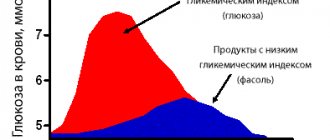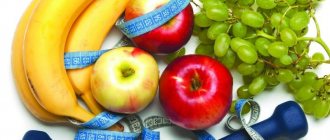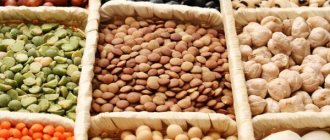What is a low glycemic index diet?
The diet is based on the dependence of a person’s body weight on the glycemic index of the foods he consumes. In the field of weight loss, this nutritional system has become a revolution, because thanks to it it is easy to lose weight, and the results remain for a long time. If you follow all the rules of the diet according to the glycemic index, you will not fail, since the main principle of the method is to lose weight without hunger.
Diet principles
In essence, the Montignac diet is a balanced diet. Following such a system, you need to choose which foods you can consume, taking into account their effect on metabolic processes: this will ensure the prevention of diabetes, excess weight and various types of vascular and heart diseases. You need to lose weight correctly - not by starving, but by calculating the GI of foods. To lose weight, this indicator should be low. Accordingly, the author developed a table dividing foods according to their glycemic index value. The following standards are used as a basis:
- low level – up to 55;
- average – 56-69;
- high – from 70.
Taking into account the initial weight, it is recommended to consume 60-180 units per day when losing weight. In addition to this, the technique
involves following a number of simple rules:
- drink at least 2 liters of still water per day;
- stick to fractional meals, dividing food into several meals. The break between them should not be more than 3 hours;
- analyze the nutritional value of dishes - do not combine fats with carbohydrates.

Green and black
The glycemic index of different types of tea is at the same level. It corresponds to zero and remains stable unless the cooking method changes. The most suitable way to brew tea:
- green - 3-5 minutes;
- black - 4-6 minutes;
- white - up to 3 minutes.
At the same time, the beneficial properties of the drinks are preserved. Recommendations are given for tea without sugar. The level of glucose in the body does not rise in this case. Hibiscus tea also has an index of 0. Its calorie content is slightly higher - 5 units. per 100 g of product. The amount of nutrients is also different: proteins - 0.3 g, carbohydrates - 0.6 g (per 100 g). The degree of usefulness of hibiscus does not decrease because of this. The carbohydrate content is so low that glucose levels may change only slightly. Minimal fluctuations have no effect on the body.

Glycemic index of weight loss foods
A special table showing the glycemic index of foods was developed to give you an idea of how quickly carbohydrates are broken down into glucose in any particular dish. The data is important for people who prefer proper nutrition and for those who suffer from diabetes and are trying to lose excess weight.
Low GI foods
Products belonging to this group can suppress hunger for a long time, because when they enter the body, the complex carbohydrates they contain take longer to be absorbed in the gastrointestinal tract and cause a gradual increase in sugar levels. The list of foods with a low glycemic index includes:
| Name | GI |
| Oysters, soy sauce, shrimp, mussels, fish | |
| Seasonings, spices | 05 |
| Cancers | 05 |
| Avocado | 10 |
| Mushrooms, walnuts, hazelnuts and pine nuts, almonds and peanuts, pistachios and hazelnuts, broccoli, zucchini, cucumbers. Green beans, ginger, red bell pepper. Sauerkraut, Brussels sprouts, cauliflower, white cabbage, spinach, rhubarb, celery. Black currants, lettuce, dill, radishes, olives, onions. | 15 |
| Cocoa, lemon juice, cherry, eggplant, unflavored yogurt, dark chocolate, artichoke. | 20 |
| Peas, beans, barley. Strawberries, blackberries, strawberries, raspberries, red currants, cherries, blueberries, gooseberries. | 25 |
| Mandarin, pomelo, grapefruit, pears, passion fruit, dried apricots. Beets, garlic, lentils, carrots, marmalade, milk, pomelo, tomatoes. | 30 |
| Quince, apricot, orange, pomegranate, nectarine, apple, peach, sesame, poppy, yogurt. Yeast, mustard, sunflower seeds, green or canned peas, corn, celery root, tomato juice. Plums, ice cream, black or red beans, whole grain or sprouted grain bread, wild rice. | 35 |
Medium Glycemic Index Foods
During the second stage of the hypoglycemic diet, you can consume:
| Name | GI |
| Wheat flour spaghetti, dry beans, oatmeal, buckwheat, carrot juice, chicory. | 40 |
| Jam, cranberries, bread, grapes, bananas, vermicelli, coconut, grapefruit juice. | 45 |
| Mango, kiwi, pineapple, persimmon, orange, apple and blueberry juice, jam and marmalade, figs. Durum pasta, crab sticks, muesli, brown rice, ground pear, canned peach. | 50 |
| Ketchup, mustard, sushi and rolls, grape juice, canned corn. | 55 |
| Cocoa with sugar, ice cream, industrial mayonnaise, lasagna, pizza with cheese and tomatoes, wheat flour pancakes, long grain rice. Melon, papaya, ready-made oatmeal. | 60 |
| Rye bread, yeast black bread, macaroni and cheese, boiled potatoes in their jackets, canned vegetables, boiled beets. Jam, raisins, maple syrup, sorbet, muesli with sugar, marmalade. | 65 |
Special food
Experts have developed a special porridge “Stop Diabetes” for type 2 diabetes. The following components provide a positive effect from possible use:
- Flax porridge.
- Amaranth leaves.
- A mixture of barley, oatmeal and buckwheat (incredibly healthy cereals).
- Ground pear.
- Onion.
- Jerusalem artichoke.
These diabetic components were not chosen by chance. They all complement each other, providing a long-term health effect if you eat the dish daily. Flaxseed porridge contains Omega 3, making muscles and tissues more responsive to insulin. The pancreas will function normally with the help of minerals that are present in large quantities.

Diabetes also requires special preparation of this porridge. The recipe is simple: 15-30 g of the contents of the package are poured with 100-150 g of warm milk - it is better to use it rather than water. Stir thoroughly, leave for 10 minutes before the second cooking period to allow the flakes to swell sufficiently.
After the allotted time, add a little of the same warm liquid so that it covers the food. The porridge can be eaten with a sugar substitute or ginger oil; before this, the porridge for diabetics can be slightly salted. There are more useful substances there than in sweets, so they will have to be replaced with something. Helpful advice: also avoid cough drops, they contain sugar. How much and when? Eat this dish daily (you can eat it twice a day in small portions). Read on for detailed recommendations for use.
ul
Blood glucose level and reasons for its increase or decrease

The average fasting blood glucose level in a healthy adult ranges from 3.3 to 5.5 mmol/L. After eating, glucose levels rise sharply for a while and then recover.
There is such a thing as the glycemic index - this is the ability to increase blood glucose levels by foods that contain carbohydrates. If its values increase, this indicates that glucose, which requires insulin for its absorption, accumulates faster and more. If these values are reduced in foods or dishes, then glucose enters the blood more slowly and evenly, and this requires a small amount of insulin.
ul
List of foods with different glycemic index (GI):
- below 15 (all types of cabbage, zucchini, spinach, sorrel, radish, radishes, turnips, cucumber, asparagus, leeks, rhubarb, sweet peppers, mushrooms, eggplants, squash);
- 15–29 (prunes, blueberries, cherries, plums, citrus fruits, lingonberries, cherries, cranberries, tomatoes, pumpkin seeds, nuts, dark chocolate, kefir, fructose);
- 30–39 (black, white, red currants, pear, fresh and dried apples, peaches, raspberries, dried apricots, peas, beans, apricots, milk, milk chocolate, low-fat fruit yogurt, lentils);
- 70–79 (raisins, beets, pineapple, watermelon, rice, boiled potatoes, ice cream, sugar, muesli, cheesecakes);
- 80–89 (baked goods, candies, carrots, caramel);
- 90–99 (white bread, baked and fried potatoes).
Two groups of hormones influence the concentration of glucose in the blood. The hormone that lowers blood glucose levels is insulin; Hormones that increase blood glucose levels are glucagon, growth hormone and glucocorticoids, adrenal hormones. Adrenaline, which is one of the stress hormones, suppresses the release of insulin into the blood. One of the symptoms of diabetes is a prolonged increase in blood glucose (hyperglycemia).
The causes of hyperglycemia can be:
- various stressful situations,
- hereditary factor
- genetic disorders
- allergic reactions,
- long-term colds, etc.
ul
Diet and cooking technology
The diet should be 5-6 meals a day with an interval between meals of 2-3 hours and the last meal 1.5-2 hours before bedtime.
- It is advisable to start breakfast with porridge with the addition of either 1 egg or 2 eggs in the form of an omelet. The volume of porridge is about 250–300 ml. Among the breakfast drinks you can use tea with milk, coffee with milk, cocoa with milk, chicory with milk. If you don’t like adding milk to these drinks, you can combine them with 45% fat hard cheese or cottage cheese.
- For second breakfast, it is recommended to make a fruit-berry-yogurt cocktail, you can add nuts and dried fruits, or use vegetable salads like Greek or Shopska or other similar salads.
- For lunch you should use first courses (red borscht, green soup, chicken soup, various broths, soups, etc.) in a volume of 250-300 ml/day. For the main course, we recommend chicken breast, chicken (remove the skin from the chicken before heat treatment), beef, veal, lean pork (in the form of meatballs, cutlets, brisoles) without adding eggs to the minced meat. Since the protein avidin, found in eggs, blocks the absorption of iron contained in meat, it is not recommended to combine it with vegetables in the same meal. To prepare minced meat, it is recommended to clean the meat from fascia and tendons, grind it twice in a meat grinder with the addition of onion and salt. It is advisable to consume meat components with porridge or whole grain pasta. It is advisable to extend the interval between meat dishes and vegetable dishes to 1–1.5 hours.
- Among the drinks, we recommend dried fruit compotes or rosehip decoction, or fruit and berry jelly, or fresh juice diluted with bottled drinking water.
- For an afternoon snack, you can use cottage cheese and fruit salad or fruit salad, or vegetable salad with a volume of 150 g/day.
- It is recommended to start dinner with fish dishes with the addition of a vegetable side dish. Drinks: tea, cocoa or chicory with milk. At night, you can drink a glass of biokefir or eat yogurt. It is advisable to drink water in the volume calculated according to the formula: 20-30 ml of liquid per kilogram of body weight. A small amendment: in the summer, the figure is 30 ml, in the spring-autumn period - 25 ml, and in the winter - 20 ml. This liquid is consumed taking into account all liquids drunk (drinks and first courses).
The cooking technology is based on the fact that it is advisable to prepare all food products without adding fat. Vegetable fats (olive, corn oil) should be added to food just before serving the dish, since as a result of heating vegetable oil, drying oil and carcinogenic substances are formed, which have a detrimental effect on the walls of blood vessels and provoke not only the development of cardiovascular pathology in humans, but also oncological pathology. Types of cooking: steaming, boiling, stewing, baking.
What to do if you have diabetes?!
We recommend reading an exclusive article on how to forget about diabetes forever... Read more >> |
ul
Nutrition according to the glycemic index - where to start
Having started to build a diet taking into account the glycemic index of foods, completely exclude those that have a high index: potatoes, sweet fruits, honey, popcorn and others. Remember that during pregnancy you should not sharply limit yourself, because these products contain components necessary for the development of the baby. Plan your diet menu so that it consists largely of beans, vegetables, dairy products, oranges, beans, and herbs. You can add sweets to the menu, for example, marmalade.
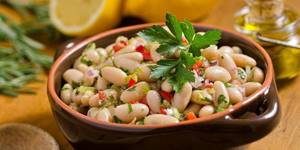
How is glucose absorbed?
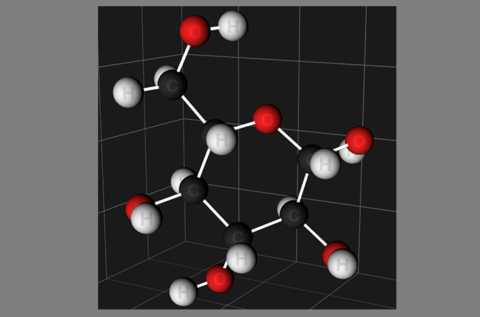
The breakdown of complex sugars to glucose (pictured) occurs due to the food enzyme amylase.
Most foods, along with proteins and fats, contain carbohydrates, which are of two types:
- Simple carbohydrates or regular sugar are a water-soluble compound of glucose and fructose.
- Complex polysaccharides or starches are quite insidious and “not always sweet” substances.
The absorption of simple carbohydrates does not require additional enzyme participation. They quickly and independently break down into their components, but in order for starches to enter the bloodstream through the intestinal walls, they must be converted into glucose.
Hypoglycemic diet
A diet based on calculating the glycemic index of foods is ideal for overweight people. The essence of the diet is:
- Avoiding a sharp drop in blood sugar, because this is the main cause of false hunger due to which the body begins to store fat obtained from the simple carbohydrates you eat in the subcutaneous tissue of the abdomen and thighs.
- Replacing simple carbohydrates with complex ones, so that sugar will not “jump” above the norm.
- Drawing up a menu, the main elements of which are complex carbohydrates - they are digested more slowly and saturate the body for a long time.
Diet stages
When considering what a diet is based on the glycemic index, you should immediately familiarize yourself with all its stages:
- The first involves consuming foods with a low GI index, due to this, active fat burning will occur. The duration of the first stage can be from 2 weeks - until your weight reaches the desired level.
- During the second stage of the glycemic index diet, you are allowed to eat foods with an average GI index - this will help consolidate the result. The duration of the stage is at least 2 weeks.
- The third stage is exiting the diet. The basis of the diet remains foods with low and medium GI, but you can gradually add carbohydrates with high GI.
How does GI affect the diabetic body?
The indicator under consideration is not a constant and unchangeable value.
The index is formed from several indicators:
- chemical composition of the product;
- method of heat treatment (cooking, stewing);
- amount of fiber;
- content of indigestible fiber.
Example: brown rice index - 50 units, peeled rice - 70 units.
This value is also influenced by factors such as:
- endemic;
- variety;
- botanical features of the species;
- ripeness.
The effect on the human body of different products is different - the higher the index, the more sugar will enter the blood during the digestion and breakdown of fiber.
An indicator equal to 0-39 units is considered safe - such cereals can be consumed in the diet with virtually no restrictions.
The average is 40-69 units, so such products should be included in the diet in limited quantities. If the indicator is 70 or higher, then such cereals can be used in the daily menu only after consultation with a specialist.
Low glycemic index menu
The advantage of the diet is a wide selection of foods that have a minimal GI. Once you understand the table, you can prepare many different dishes for yourself, arranging the ingredients together. Remember that one of the main principles of combining dishes according to a diet is that breakfast should be hearty, lunch should be half as low in calories, and dinner should be light. A low glycemic index menu for one day looks something like this:
- breakfast - oatmeal with dried fruits or an apple, fruit juice (preferably apple) or milk with 0% fat content;
- lunch - the first course of any vegetables, you can add cereals, for example, barley. A slice of wholemeal rye bread, a few plums for dessert;
- afternoon snack and snacks - herbal, green tea or kefir, still water;
- dinner – boiled lentils, a small piece of lean white meat (or chicken fillet). Another option is a glass of low-fat yogurt and a vegetable salad dressed with olive oil.
- Losing weight by dancing at home
- How to trim a cat's claws
- Simple diet for losing belly fat
Secrets of decoy
And our favorite porridge is the most harmful. There is a lot of starch in semolina, and its GI is off the charts, but there is little protein, vitamins, minerals and other benefits. Semolina is generally a special grain; in fact, it is a by-product formed during the production of wheat flour. After grinding, 2% of small fragments of grain always remain, which are only slightly larger than flour dust - this is semolina.
Fans of semolina porridge do not realize that there are three types of semolina on sale, which differ slightly in their harmfulness. The most unhealthy and most common is made from soft varieties of wheat. To identify it, you need to have a higher consumer education: on the packaging it is indicated by the code “brand M” or simply the letter “M”, which tells the buyer little. The best semolina, but not always the tastiest, is made from durum wheat and is designated by the letter “T”. And semolina with “MT” on the package is neither this nor that, a mixture of soft and hard wheat (the latter should be at least 20%). Why we invented such a label that is incomprehensible to consumers, one can only guess. But what’s more, even this information is often not indicated on the packaging.
Rice is close in “healthiness” to semolina. True, there are several types of really healthy rice. Brown rice is not polished, and it retains the brownish pityriasis shell, in which vitamins B1, B2, E and PP are concentrated. Long grain rice is not bad, it is less overcooked and has a low GI.
Recipes using low glycemic index foods
Dishes that can be made from foods with a low glycemic index, once in the stomach, will not cause a sharp increase in sugar. This means that after eating such food, your body will be full for a long time and you will not want to have snacks between meals. Check out some recipes for a hypoglycemic diet - with them you can achieve the desired result in losing weight.
Meat cabbage soup
- Cooking time: 50 minutes.
- Number of servings: 3 persons.
- Calorie content of the dish: 55 kcal.
- Purpose: for lunch.
- Cuisine: Russian.
- Difficulty of preparation: easy.
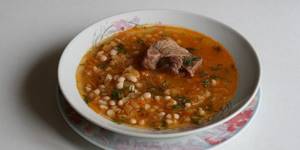
Cabbage soup with the addition of fillet or lean meat on the bone is one of the most satisfying and nutritious dishes allowed at any stage of a hypoglycemic diet. The list of ingredients for the first includes vegetables that are recommended to be consumed fresh, but even after heat treatment their GI will not be much higher than recommended even at the first stage.
Ingredients:
- tomato – 1 pc.;
- red sweet pepper – 1 pc.;
- potatoes – 2 pcs.;
- onion – 1 pc.;
- cabbage – 0.25 heads;
- carrots – 1 pc.;
- lean meat – 300 g;
- bay leaf, spices, salt, herbs - to taste.
Cooking method:
- Boil the meat by placing a piece in cold water.
- Chop the tomato, carrot, pepper and onion, fry a little, pouring a little vegetable oil into the pan.
- Shred the cabbage thinly.
- Peel the potatoes and make into cubes.
- Add cabbage to the broth with the cooked meat after 10 minutes. add potatoes. After boiling the ingredients for 10 minutes, add the remaining vegetables.
- Leave the cabbage soup on the fire for 10 minutes, then add seasonings and salt. After a minute, turn off the heat.
Braised cabbage
- Cooking time: 35 minutes.
- Number of servings: 5 persons.
- Calorie content of the dish: 40 kcal.
- Purpose: for lunch.
- Cuisine: Russian.
- Difficulty of preparation: easy.
A diet according to the glycemic index helps everyone achieve the desired results in losing weight, because dishes can be prepared in different ways: steamed, baked or stewed. Try cooking cabbage, a vegetable that is on the list of low GI foods. When dieting, stewed cabbage should be prepared without adding oil. You can use vegetable or meat broths instead.

Ingredients:
- onion – 1 pc.;
- cloves – 1 pc.;
- cabbage – 1 kg;
- broth - 2 tbsp.;
- tomato puree – 2 tbsp. l.;
- bay leaf, peppercorns, salt - to taste.
Cooking method:
- Chop the cabbage thinly and place in a cauldron. Let it simmer, adding broth.
- Fry the chopped onion and mix with tomato paste.
- Add prepared onions and spices to soft cabbage.
- Extinguish all min. 10, cover with a lid and let the dish stand for a while.
Salad with chicken, cucumbers and avocado
- Cooking time: 50 minutes.
- Number of servings: 2 persons.
- Calorie content of the dish: 65 kcal.
- Purpose: for dinner.
- Cuisine: Russian.
- Difficulty of preparation: easy.
Many people like the hypoglycemic diet, because here the menu can be absolutely anything, the main condition is that the dishes consist of foods with a low or medium glycemic index. By following such a nutrition system, you will not starve, and your diet will be filled with your favorite food. Diversify your diet menu with a light and tasty salad with chicken, avocado and cucumbers.
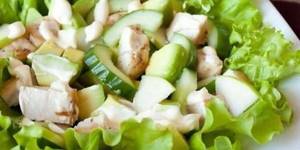
Ingredients:
- cucumbers – 2 pcs.;
- garlic – 2 cloves;
- soy sauce – 6 tbsp. l.;
- sesame seeds, green onions - to taste;
- eggs – 3 pcs.;
- avocado – 1 pc.;
- mustard – 1 tsp;
- chicken breast – 1 pc.
Cooking method:
- Boil the chicken breast, tear into fibers.
- Boil eggs, cut into cubes.
- Chop the cucumbers into thin slices.
- Chop the avocado into small cubes.
- Mix the prepared ingredients in a bowl.
- Prepare the dressing: mix mustard with soy sauce, chopped garlic and onion feathers. Pour the mixture into the salad, sprinkle everything with sesame seeds.
Stovetop Recipes
Barley porridge can be prepared not only as a side dish, but also as a complex dish, supplementing the recipe with vegetables, mushrooms or meat. A possible option for preparing such a complex dish is described below.
The recipe uses champignon mushrooms, but according to personal taste preferences, you can choose other varieties. Mushrooms, regardless of variety, have a low GI, not exceeding 35 units.
This second course can also be served to people observing fasting.
- Rinse 200 grams of barley under running water, place in a saucepan and add 400 ml of water, add salt.
- Bring the porridge to a boil, reduce heat and cook, covered, until the water evaporates, about 30 - 35 minutes.
- In a frying pan, fry one onion, diced, 30 grams of champignons, cut into quarters, add salt and pepper.
- a few minutes before the end of cooking the mushrooms, add finely chopped garlic and herbs to them.
- mix the prepared porridge and mushroom mixture.
Barley porridge with mushrooms will be an excellent first breakfast and will leave you feeling full for a long time. It also goes well with cutlets. Just remember that cutlets for diabetics are prepared exclusively from homemade minced meat. This allows you to prepare a healthy meat product, free of harmful fat, which is often used by unscrupulous companies in the production of minced meat.
In the video in this article, Elena Malysheva will talk about the various benefits of barley.
Pros and cons of the diet
The glycemic index diet impresses everyone who wants to lose weight with its advantages:
- even when going through the first stage of the diet, hunger strike is excluded, because the menu is varied and nutritious: the diet is based on the principles of proper nutrition;
- You can stay on a diet for the rest of your life, because it benefits the body: it speeds up metabolism, improves intestinal function, and normalizes the functioning of all internal organs;
- You can build a diet from dietary products during pregnancy and breastfeeding, and for people who suffer from various kinds of chronic or serious diseases.
As for the disadvantages, a low-glycemic diet has practically none. However, nutrition according to the glycemic index is not recommended for adolescents and those who have problems such as:
- impaired metabolism;
- mental disorders;
- diabetes mellitus;
- weakened condition after surgery or a long illness.
The relative disadvantages of the glycemic index diet are that when following it, you must constantly follow the table compiled by experts and the fact that it is impossible to achieve rapid weight loss with it. Even if you make every effort, you can lose up to 10 kg in a month, and the result of weight loss is significantly influenced by the calorie content of food consumed and the amount of physical activity.
Benefits of cells
Barley is what barley groats are made from. Its invaluable benefit lies in the fact that the barley itself is not polished, but only crushed, which preserves its beneficial properties in the shell. Barley is also processed into pearl barley, which is also recommended for diabetics.
Barley groats for diabetes are valuable because they have low calorie content, and obesity is a problem for many patients. Often, it is the abdominal type of obesity that provokes the non-insulin-dependent type of diabetes mellitus.
Thanks to dietary fiber, this porridge is digested slowly and gives you a feeling of fullness for a long time. Its use will save the patient from snacks that are not approved by doctors, mainly in type 1 diabetes. After all, then the person needs to calculate an additional injection of short-acting insulin. A 200 gram serving of egg contains only 150 kcal.

